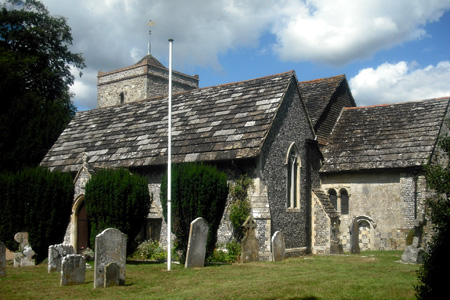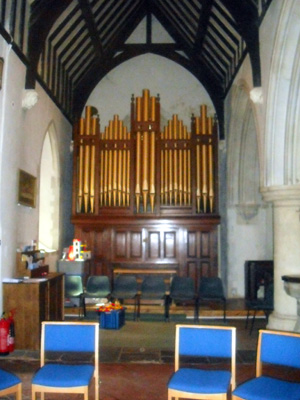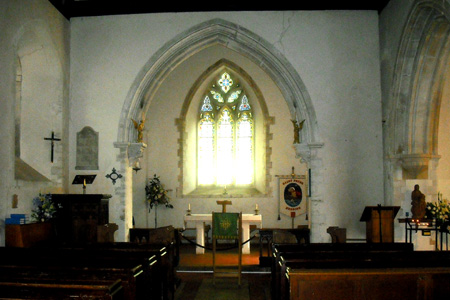| |
 |
 |
 |
| Comment on this report, or find other reports. |
 |
| Our Mystery Worshippers are volunteers who warm church pews for us around the world. If you'd like to become a Mystery Worshipper, start here. |
 |
| Find out how to reproduce this report in your church magazine or website. |
|
|
| 3056: St Peter, Upper Beeding, England |
 |
 |
 |
Mystery Worshipper: Teutonic Knight.
The church: St Peter, Upper Beeding, West Sussex, England.
Denomination: Church of England, Diocese of Chichester.
The building: Dating from Saxon times, it was enlarged by Norman noblemen. In the 13th century it was extended eastward and southward into a longer and wider nave with two side chapels and new chancel. A low squat tower was built in the medieval period; it barely rises above the height of the nave, but it houses a formidable peal of eight bells. The two oldest of these are thought to have been cast in the early 14th century. The Victorians added a south aisle and porch, and roofed it with local stone. Inside, there are some contemporary ornaments, artwork and architectural features. A new and unattractive stone altar was consecrated in 1984. A beautiful wooden statue of the Virgin and Child in the Lady chapel is said to be a scaled-down copy of Michelangelo's marble original in Bruges Cathedral. There is some elaborate stained glass, but the east window is not one of them. Probably the most notable feature is an attractive corona by Pugin that is one of a set of thirteen, the other twelve of which are to be found in the House of Lords.
The church: St Peter's is the principal church of the three churches that comprise the united benefice of Beeding, Bramber and Botolph, affectionately known locally as the "Three Bees" with busy bees buzzing around on church posters. They serve village communities on both sides of the river Adur a few miles from the Channel. The parish has a regular pattern of worship using all three churches, though St Nicholas is now more or less entrusted to "friends of the church" rather than a worshipping community. There is a monthly Taizé service, and they appear to have several toddler, children's, youth, house and fellowship groups, and also a group called "Flying Buttresses" who support the work of the church while not necessarily actively worshipping.
The neighbourhood: Upper Beeding (not to be confused with Lower Beeding, which is actually more northerly) nestles at the foot of the South Downs close to the banks of the river Adur. The river is popular with canoeists, though it is tidal. Bramber Castle was one of a chain of Norman castles across Sussex and is a stone's throw away. Only parts of this once massive structure remain. There are spectacular views both of the Downs and downriver towards the sea from here. Also nearby is St Mary's House, built in 1470 as an inn to accommodate pilgrims en route to the shrine of St Thomas ŕ Becket in Canterbury. Lancing College, a famous English public school with a Victorian chapel of cathedral proportions and splendour, is only a few miles downriver.
The cast: The Revd John Challis, rector; the Revd Deacon Stephanie Gardner. Lay Reader James McGuire only had a walk-on part. Two boys in red cassocks and white cottas served.
The date & time: Tenth Sunday after Trinity, 31 July 2016, 10.00am.
What was the name of the service?
The Challis Family Farewell Eucharist.
How full was the building?
Full. We weren't crushed in the pews, but full to capacity – I guess about 100 people.
Did anyone welcome you personally?
There was quite a procession up the trimmed yew bush avenue to the porch, and we were handed the specially produced order of service for the occasion, together with a pew sheet and a flyer advertising a forthcoming concert. I was invited to "sit anywhere," having been identified as an outsider. However, this seemed to be a larger than usual gathering with some more irregular worshippers and locals who wished to give their vicar a good send-off. It was his final day in the parish.
Was your pew comfortable?
I didn't notice anything, so probably better than usual. There were the typical embroidered kneelers that no one attempted to use, so they were stacked under the pews.
How would you describe the pre-service
atmosphere?
This was a special occasion and possibly not typical, but it was noisy with a lot of talking. We were graced with a band of visiting ringers who made a joyful sound before the start of the service. The ringers finished their morning duty and left as more worshippers were coming in. It felt a bit like a market place. Quite a few young children were playing with toys designed for carpets rather than hard church floors, adding to the din. Music started up from an electronic device and a disembodied voice from the back announced the first hymn. I was so surprised by this that I almost missed the opening words. There was no clear point to mark the beginning of the service and so people stood only as the procession passed them, causing a ripple effect.
What were the exact opening words of the
service?
"At my licensing we sang 'Christ triumphant.' So now we sing 'Christ triumphant.'"
What books did the congregation use during the
service?
Anglican Hymns Old & New (words edition), the specially produced order of service for the occasion, and a pew sheet.
What musical instruments were played?
There was an organ by T Hopkins & Sons of York, rebuilt by Henry Groves & Sons Ltd of Nottingham to commemorate the Queen's Silver Jubilee in 1977, but sadly it remained silent. Instead we had music from a computerised mixing deck at the back of the church, about which the least said the better. A sizeable but unrobed choir with a handful of men was assembled in the Lady chapel in the south aisle. Sadly, they appeared unable to hear the pitch, save for one rather pleasant solo voice.

Did anything distract you?
The lady who sat next to me struggled with the order of service and pew sheet, and also to locate the right hymns in the book. Her confusion, as was everybody else's, was aggravated by the fact that the first readings in the pew sheet did not match the one we heard, nor did we have the psalm or a second reading before the gospel. Oh, the pitfalls of the pew sheet!
Was the worship stiff-upper-lip, happy clappy, or
what?
The style was clearly relaxed and at the lower end of the catholic candle. The cast were in full regalia, and there was a low key gospel procession with the deacon proclaiming the gospel. There was a bit of showmanship though. After the confession, and before absolution and Gloria, the priest called the children forward to show them exactly what happens to our sins when we confess them honestly to God. He had prepared a sheet of flash paper with all his regrets, omissions and faults in his time in the parish written on them. He showed this to the children – but not close enough for them to read – and then set fire to it. It completely dissolved and literally went up to heaven in a fireball without leaving any traces at all.
At the consecration, the rector gave a solo rendition of "This is my body" in a sonorous and deep voice. And though this was an unexpected use of liturgy, it is the first time that I could actually picture Jesus himself at the Last Supper. The fact that the rector did not manage to keep time with the canned music only served to emphasise the impression of a troubled soul, of someone delivering his dying speech to those he loved.
Exactly how long was the sermon?
20 minutes.
On a scale of 1-10, how good was the preacher?
8 – The rector was well-prepared albeit – understandably – a bit emotional and personal. He appeared to be an approachable and larger than life character who is quite laid-back while at the same time quietly self-effacing in his preaching. This was a theological farewell speech, but not a dying speech.
In a nutshell, what was the sermon
about?
His text was Ecclesiastes 3 (everything has its time). He also referred to the words of the hymns we sang, in which celebration and sadness are expressed, and the many ways in which we can give our thanks both to people and to God, and ways in which to say farewell. He asked what the highlights of our lives were. Answering for himself, he said that walking alongside people and accompanying them in pain and joy as well as everyday situations was a reflection of the love of God. Worshipping in church is part of expressing gratitude. We come to church not for our own edification, or because we like the vicar or the music, but to give glory to God. Unquestioningly the biggest mission and deepest joy for him had been ministry to young people, not in a religious but a general sense, and listening to life stories of parishioners and seeing in them the depth of the love of God at work. We cannot possibly return the love of God, because we are small and God is great. Instead, we have to "pay it forward" without expectation of reward. The challenge is to look outward rather than inward. He urged his flock not to worry about themselves and scatter – the fate of many communities who lose their leader – but to stick together and grow in unity.
Which part of the service was like being in
heaven?
A priest who realises that he is given to the parish, rather than the parish to him, and who does not like to have his name on the "vicar board" at the beginning of his ministry in a parish, but rather after having "paid forward."

And which part was like being in... er... the other place?
The pew sheet, which did not match the readings, and the awful canned versions of perfectly decent hymns.
What happened when you hung around after the service looking lost?
General thanks and presentations were given, followed by a version of "An Irish Blessing" accompanied by the only live keyboard playing of the entire service – the choir's farewell to their incumbent. It felt a bit like I had gate-crashed either a wedding or a wake, so I quietly slipped away leaving the locals to say their farewells.
How would you describe the after-service
coffee?
I was sorely tempted to join them in the rectory garden for the BBQ.
How would you feel about making this church your regular (where 10 = ecstatic, 0 = terminal)?
7 – I would struggle with the music. I prefer no hymns at all to unpredictable canned versions. But I give them full marks for the sense of purpose in the congregation at the end of an incumbency. They did not come across as a bunch of headless chickens.
Did the service make you feel glad to be a
Christian?
I felt certain that this congregation will not descend into apathy and self-pity during an interregnum, and that this is a place where Christ is the Head and will continue to be among His people.
What one thing will you remember about all this in seven days' time?
Seeing Jesus at the Last Supper, caught up in his mission and ministry. |
|
|
 |
 |
 |
| We rely on voluntary donations to stay online. If you're a regular visitor to Ship of Fools, please consider supporting us. |
 |
 |
 |
| The Mystery Pilgrim |
 |
| One of our most seasoned reporters makes the Camino pilgrimage to Santiago de Compostela in Spain. Read here. |
 |
 |
 |
| London churches |
 |
| Read reports from 70 London churches, visited by a small army of Mystery Worshippers on one single Sunday. Read here. |
| |
|
|
|
|


